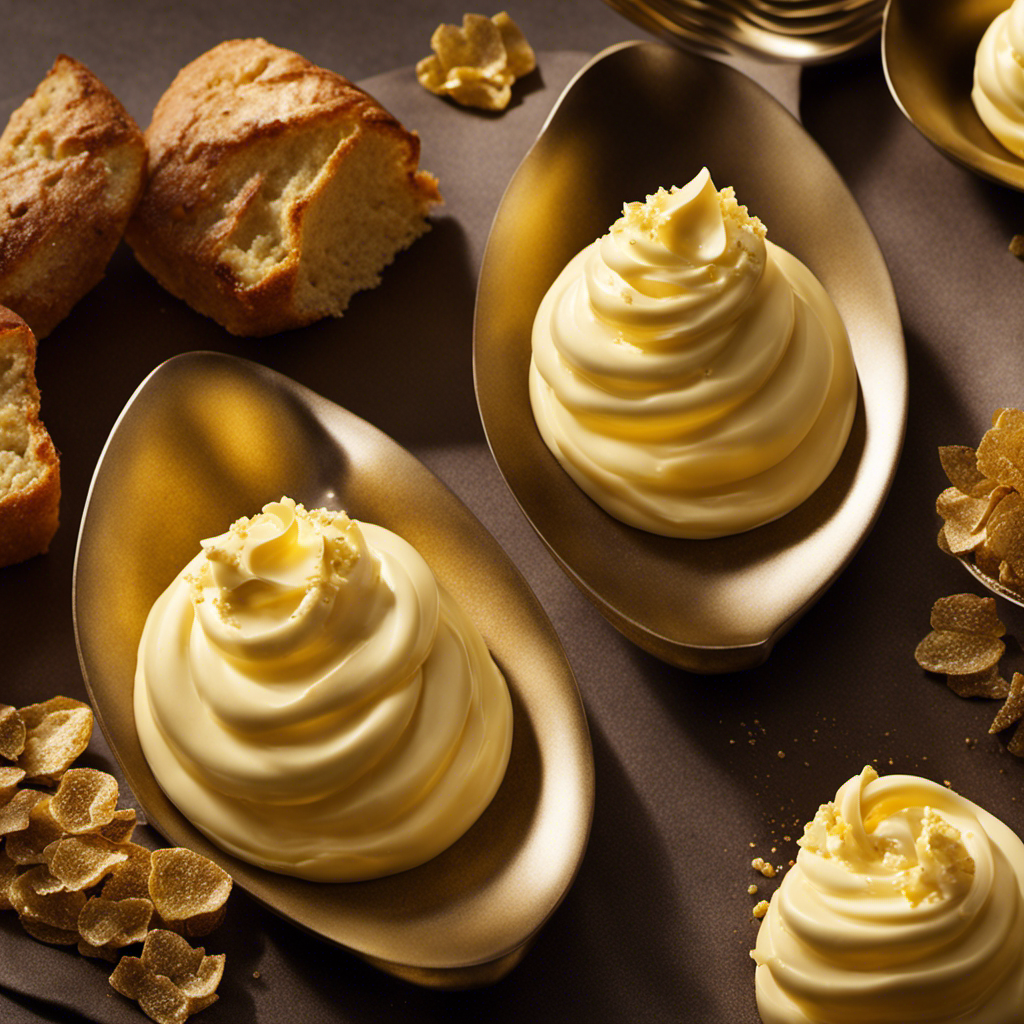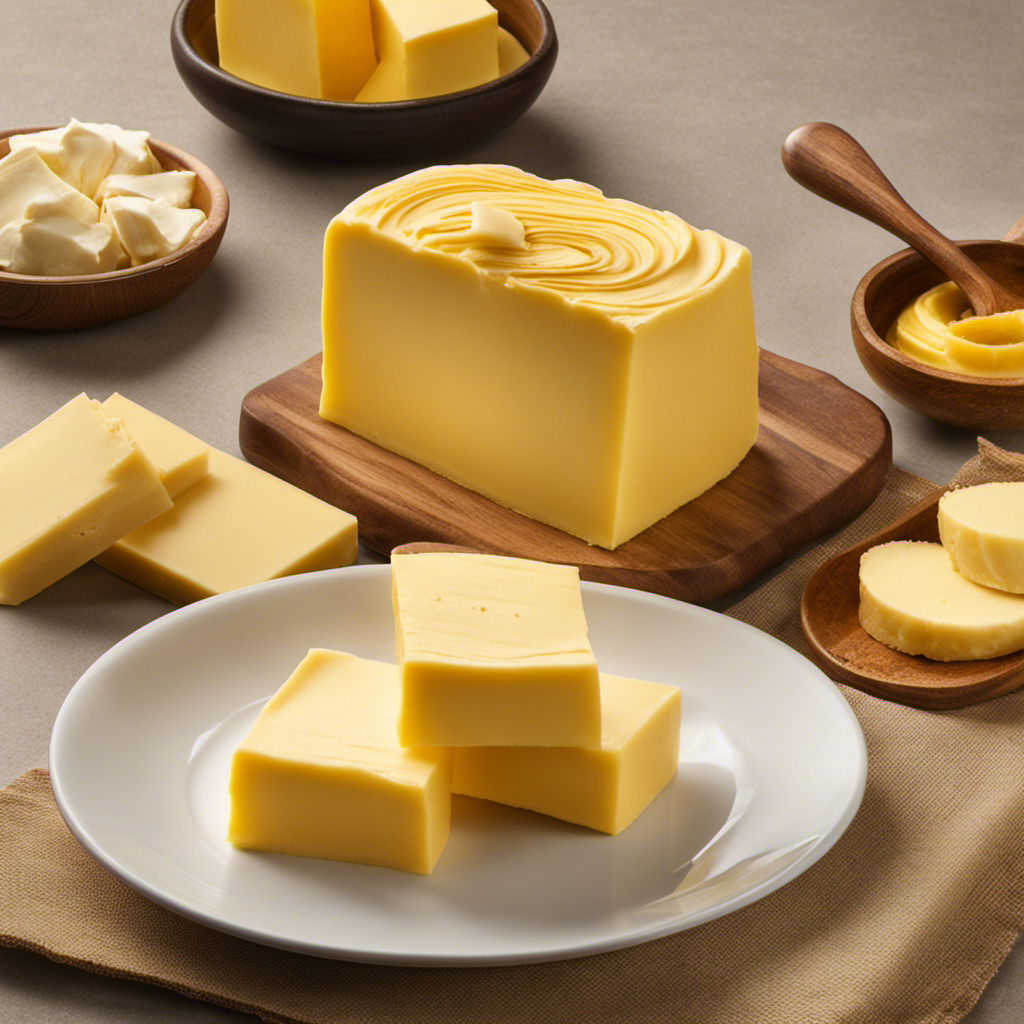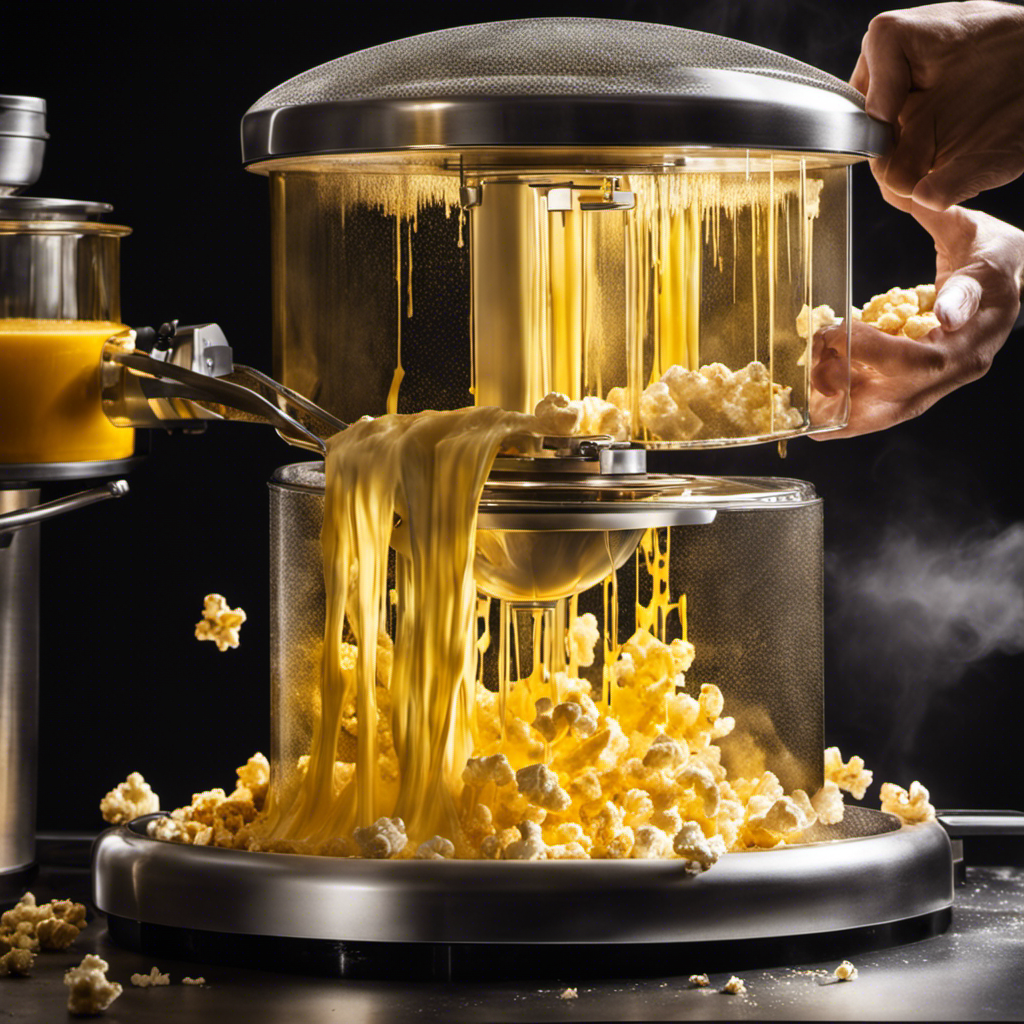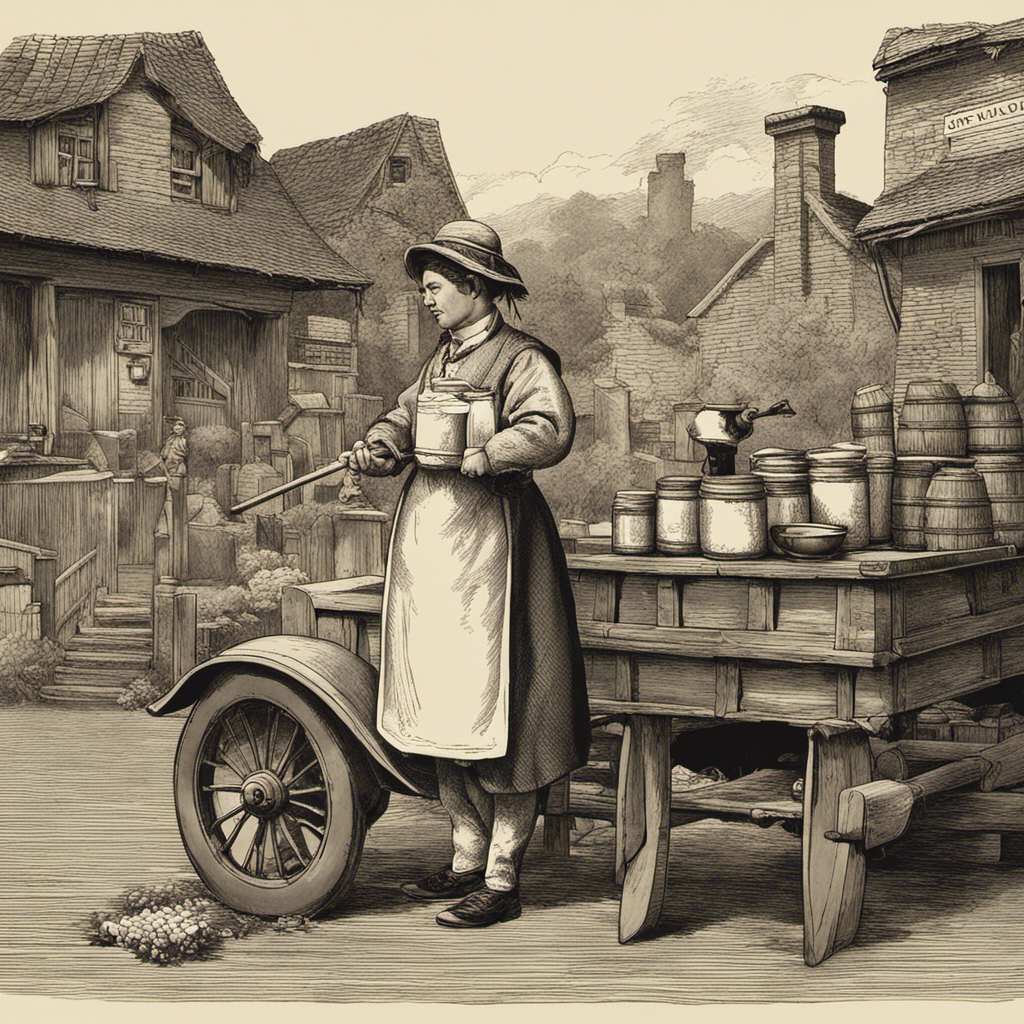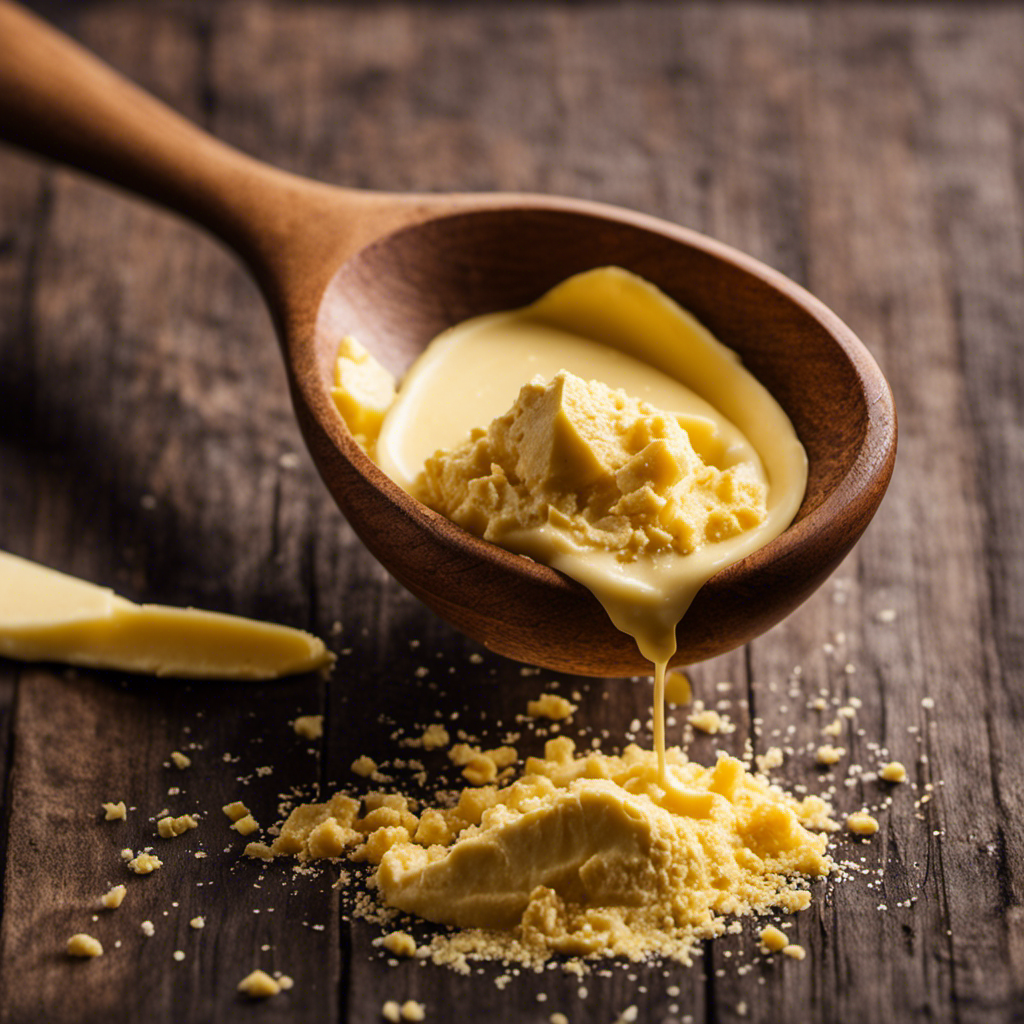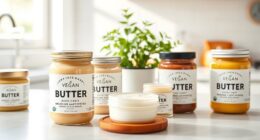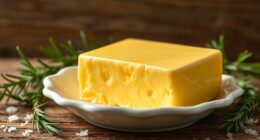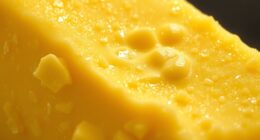It’s often said that ‘everything tastes better with butter,’ but have you ever considered the calorie content in a tablespoon of this smooth condiment?
In this article, we’ll explore the nutritional value of butter and uncover the truth about its calorie content. As a registered dietitian, I believe in providing evidence-based information to help you make informed decisions about your diet.
So, let’s dive in and find out just how many calories are packed into that tablespoon of butter.
Key Takeaways
- Butter contains approximately 100-102 calories per tablespoon.
- Butter is primarily composed of saturated fats.
- Elevated LDL cholesterol from saturated fats is a risk factor for heart disease, but recent studies have challenged this link.
- Healthier alternatives like olive oil or avocado can be used as spreads instead of butter.
The Nutritional Value of Butter
You should know that butter contains about 100 calories per tablespoon.
As a registered dietitian, I rely on scientific research and evidence to provide accurate and reliable information.
So, let’s talk about the nutritional value of butter and its impact on cholesterol levels and heart health.
Butter is primarily composed of saturated fats, which can increase levels of LDL cholesterol, the ‘bad’ cholesterol, in the blood. Elevated LDL cholesterol is a risk factor for heart disease.
However, it’s important to note that recent studies have challenged the link between saturated fats and heart disease.
Moderation is key when it comes to butter consumption. Incorporating it into a balanced diet that includes a variety of foods can be part of a healthy eating plan.
It’s also important to consider alternative options, such as using olive oil or avocado as spreads, which are rich in heart-healthy monounsaturated fats.
Butter and Calorie Count
If you’re curious about the calorie content, a tablespoon of butter contains approximately 102 calories. Butter is a rich source of fat, with approximately 11.5 grams of fat per tablespoon. It also contains small amounts of cholesterol and sodium.
While butter can be enjoyed in moderation as part of a balanced diet, it is important to consider its impact on cholesterol levels and heart health. Butter is high in saturated fat, which has been associated with an increased risk of heart disease. It is recommended to limit saturated fat intake and choose healthier alternatives like olive oil or avocado.
It’s important to note that individual dietary needs and preferences may vary, so consulting with a registered dietitian or nutritionist can help provide personalized advice and guidance.
Understanding Calories in Butter
The calorie content of a tablespoon of butter is approximately 102. Butter is a high-calorie food and can contribute to weight gain if consumed in excess. It is important to be mindful of portion sizes when using butter in cooking or spreading it on toast.
While butter does contain cholesterol, research suggests that the impact of dietary cholesterol on blood cholesterol levels is minimal for most people. However, individuals with high cholesterol levels or a history of heart disease may want to limit their intake of saturated fats, including butter. It is always a good idea to consult with a healthcare professional or registered dietitian for personalized advice.
In the next section, we will explore how calories are measured in butter and discuss the different types of butter available.
How Calories Are Measured in Butter
To measure the calories in butter, we can use a food scale or consult the nutrition label. As a registered dietitian, my goal is to provide accurate and evidence-based information.
When it comes to the calorie content of butter, it’s important to note that one tablespoon of butter contains approximately 102 calories. Additionally, butter is primarily composed of fat, with a small amount of protein and no carbohydrates.
While butter can be enjoyed in moderation, it’s essential to be mindful of its calorie content, especially if you’re looking to reduce calorie intake. To do so, you can opt for lower-calorie alternatives such as olive oil or avocado spread. Additionally, using butter sparingly or incorporating healthier cooking methods like grilling or steaming can help reduce calorie intake.
Butter and Weight Management
When managing weight, it’s important to be mindful of the amount of butter consumed. As a registered dietitian, I strive to provide accurate and evidence-based information.
Butter contains approximately 102 calories per tablespoon. It is important to note that butter is high in saturated fat, which can raise cholesterol levels and increase the risk of heart disease when consumed in excess. However, it can still be enjoyed in moderation as part of a balanced diet.
If you’re looking for a healthier alternative, consider using butter substitutes such as olive oil or avocado spread. These options are lower in saturated fat and can provide similar flavors and textures.
Butter and Daily Caloric Intake
When it comes to butter and its impact on weight, understanding the calorie content is crucial. In a tablespoon of butter, there are approximately 100 calories, making it a calorie-dense food.
However, it’s important to consider the overall composition of butter and its potential health effects before drawing conclusions about its impact on weight.
Exploring healthier alternatives and finding ways to incorporate butter into a balanced diet can provide practical solutions for those looking to manage their weight while still enjoying its rich flavor.
Butter Calorie Content
You’ll be surprised to know that a tablespoon of butter contains about 100 calories.
Butter is primarily made up of fat, with each tablespoon containing approximately 11 grams of fat. This includes both saturated and unsaturated fats.
Saturated fat can negatively impact heart health when consumed in excess, as it can raise levels of LDL cholesterol in the blood. Therefore, it is important to consume butter in moderation.
However, there are alternatives to butter that can be used in cooking and baking. These include olive oil, avocado, and nut butters, which provide healthier fats and additional nutrients.
When choosing to include butter in your diet, it is recommended to consider portion sizes and balance it with other healthy fats.
Overall, moderation and variety are key in maintaining a balanced and heart-healthy diet.
Impact on Weight
The impact of butter on weight can be influenced by portion sizes and incorporating other healthy fats into your diet. When it comes to weight loss, it’s important to consider the overall balance of your diet and the amount of butter you consume.
Here are a few key points to keep in mind:
-
Portion control: Butter is high in calories, with about 102 calories per tablespoon. It’s important to be mindful of the amount of butter you use in cooking or as a spread.
-
Nutritional composition: Butter is primarily made up of saturated fats. While it can be part of a balanced diet, it’s important to limit saturated fat intake and opt for healthier fats like olive oil or avocado.
-
Alternative options: If you’re looking to reduce your butter consumption for weight loss, consider using alternatives like ghee or nut butters, which offer similar flavors and textures with fewer calories.
Healthy Alternatives
When it comes to incorporating butter into a healthy eating plan, there are some healthy swaps and portion control strategies that can be beneficial. Instead of using a full tablespoon of butter, you can try using half a tablespoon or even a teaspoon to reduce the overall calorie content. Additionally, you can opt for healthier alternatives to butter, such as avocado, olive oil, or nut butter, which provide similar richness and flavor while offering additional nutritional benefits. To help you make informed choices, I have provided a table below comparing the calories and nutritional composition of butter with some popular alternatives:
| Calories (per tbsp) | Total Fat (g) | Saturated Fat (g) | Cholesterol (mg) | |
|---|---|---|---|---|
| Butter | 102 | 12 | 7 | 31 |
| Avocado Spread | 44 | 4 | 1 | 0 |
| Olive Oil | 119 | 14 | 2 | 0 |
| Almond Butter | 98 | 9 | 1 | 0 |
| Peanut Butter (unsalted) | 94 | 8 | 2 | 0 |
Comparing Butter to Other Fats
Comparing butter to other fats, it’s important to consider the calorie content per tablespoon. While butter adds flavor and richness to dishes, it also contains a significant amount of calories. Here are some key points to consider:
- Butter has approximately 102 calories per tablespoon.
- Margarine, a popular butter substitute, has a similar calorie content.
- Consuming excessive amounts of saturated fats, like those found in butter, can increase the risk of heart disease.
As a registered dietitian, I believe it’s important to emphasize moderation when it comes to consuming butter. While it can be enjoyed as part of a balanced diet, it’s essential to be mindful of portion sizes and opt for healthier fat sources whenever possible.
Ultimately, choosing a variety of fats, such as avocados, nuts, and olive oil, can provide a wider range of nutrients and potentially reduce the risk of heart disease.
Butter and Macronutrients
When it comes to butter, it’s important to understand its calorie content and macronutrient composition.
In a tablespoon of butter, there are approximately 100 calories.
Additionally, butter is primarily made up of fat, with minimal amounts of protein and carbohydrates.
Butter’s Calorie Content
To find out how many calories are in a tablespoon of butter, you can check the nutrition label on the packaging. Butter is a common ingredient in many recipes, but it’s important to be mindful of its calorie content. Here are some key points to consider:
-
Butter’s nutritional value: Butter is primarily composed of fat, with a small amount of protein and carbohydrates. It is a concentrated source of calories, providing around 102 calories per tablespoon.
-
Butter and weight loss: Due to its high calorie content, consuming butter in excess can contribute to weight gain. However, moderate amounts of butter can be included in a balanced diet without hindering weight loss goals. Portion control and mindful eating are key.
-
Incorporating butter into a healthy eating plan: If you enjoy the flavor of butter, try using it sparingly and opt for healthier cooking oils or spreads as alternatives. Experimenting with herbs and spices can also enhance the taste of dishes without relying heavily on butter.
Macronutrient Composition of Butter
Butter has often been associated with concerns about cholesterol levels and heart health. However, it is important to understand the impact of butter on these aspects.
While butter does contain cholesterol, research has shown that dietary cholesterol has a minimal effect on blood cholesterol levels for most individuals. The main concern with butter lies in its high saturated fat content. Saturated fats can raise LDL (bad) cholesterol levels, which may increase the risk of heart disease.
Therefore, it is recommended to consume butter in moderation as part of a balanced diet. Choosing healthier alternatives, such as olive oil or avocado, can be beneficial for heart health.
It is also important to consider the overall dietary pattern, including other sources of saturated fats, and prioritize a variety of nutrient-rich foods for optimal heart health.
Butter and Micronutrients
You should be aware that butter contains essential micronutrients like vitamins A, D, and E. These vitamins play crucial roles in maintaining overall health and well-being.
Here are some key points to remember about the micronutrients in butter:
-
Vitamin A: Butter is a good source of vitamin A, which is important for healthy vision, immune function, and cell growth.
-
Vitamin D: Butter contains small amounts of vitamin D, which is essential for strong bones and teeth, as well as supporting immune function.
-
Vitamin E: Butter provides a small amount of vitamin E, a powerful antioxidant that helps protect cells from damage.
While it’s true that butter is high in saturated fat and can raise cholesterol levels, it is important to remember that moderation is key. Incorporating butter into a balanced diet, along with other healthy fats, can be part of a heart-healthy eating plan.
It’s always a good idea to consult with a registered dietitian or nutritionist to find the right balance for your individual needs.
Butter and Calorie-dense Recipes
In my previous section, I discussed the role of butter as a source of essential micronutrients. Now, let’s shift our focus to another aspect of butter: its use in calorie-dense recipes, particularly in baking. Butter is a common ingredient in baking as it provides a rich flavor and helps create a tender texture in baked goods. However, it’s important to remember that butter is high in calories and saturated fat.
To give you a better understanding, let’s take a look at the nutritional composition of a tablespoon of butter:
| Nutrient | Amount |
|---|---|
| Calories | 102 |
| Total Fat | 11.5g |
| Saturated Fat | 7.3g |
| Cholesterol | 31mg |
| Sodium | 91mg |
While butter can certainly enhance the taste and texture of your baked goods, it’s crucial to be mindful of your overall calorie and fat intake, especially if you are concerned about heart health. Moderation is key.
Now, let’s explore some practical tips for moderating butter consumption in the next section.
Tips for Moderating Butter Consumption
If you’re looking to reduce your butter intake, there are some simple tips that can help. Moderating butter intake is all about portion control and finding alternatives that can still add flavor to your dishes. Here are a few tips to get started:
-
Measure your butter: Use measuring spoons or a kitchen scale to accurately portion out your butter. This will help you keep track of how much you’re using and prevent overconsumption.
-
Experiment with alternatives: Try using spreads like avocado, hummus, or nut butter instead of butter. These options can provide a similar creamy texture and taste while offering different nutritional benefits.
-
Use herbs and spices: Enhance the flavor of your meals with herbs and spices instead of relying on butter. Fresh herbs like basil, cilantro, and thyme, or spices like garlic powder, paprika, and cumin can add depth and complexity to your dishes without the need for excessive butter.
Frequently Asked Questions
Can Butter Be a Part of a Healthy Diet?
Butter can be a part of a healthy diet when consumed in moderation. It provides essential nutrients and can add flavor to meals. However, it is important to be mindful of portion sizes and balance it with other nutritious foods.
How Does the Calorie Content of Butter Compare to Other Spreads?
When comparing the calorie content of spreads, it’s important to consider the nutritional benefits of alternatives like margarine and olive oil. I’ll provide detailed information on the calories in a tablespoon of butter and how it fits into a balanced diet.
What Are Some Alternatives to Butter With Lower Calorie Content?
There are many low-calorie spreads and butter alternatives available. These options can help reduce calorie intake while still providing flavor and texture. It’s important to read labels and choose options that fit into a balanced diet.
Does the Type of Butter (Salted, Unsalted, Grass-Fed) Affect Its Calorie Count?
The calorie content of different types of butter can vary, including salted, unsalted, and grass-fed options. It’s important to consider the impact of butter on cholesterol levels and incorporate it into a balanced diet.
Can Consuming Too Much Butter Lead to Weight Gain?
Consuming too much butter can lead to weight gain. It is important to moderate butter intake as it is high in calories and saturated fat, which can increase cholesterol levels and be linked to heart disease.
Conclusion
In conclusion, understanding the calories in a tablespoon of butter is crucial for managing weight and maintaining a balanced diet.
Registered dietitians and nutritionists provide evidence-based information to educate readers on the nutritional composition and potential health effects of butter. They present information in a clear and understandable manner, avoiding complex terminology.
Their impartial and unbiased approach highlights both the benefits and limitations of consuming butter, while offering practical advice for incorporating it into a healthy eating plan.
Overall, their focus is on promoting overall well-being rather than endorsing specific products.
